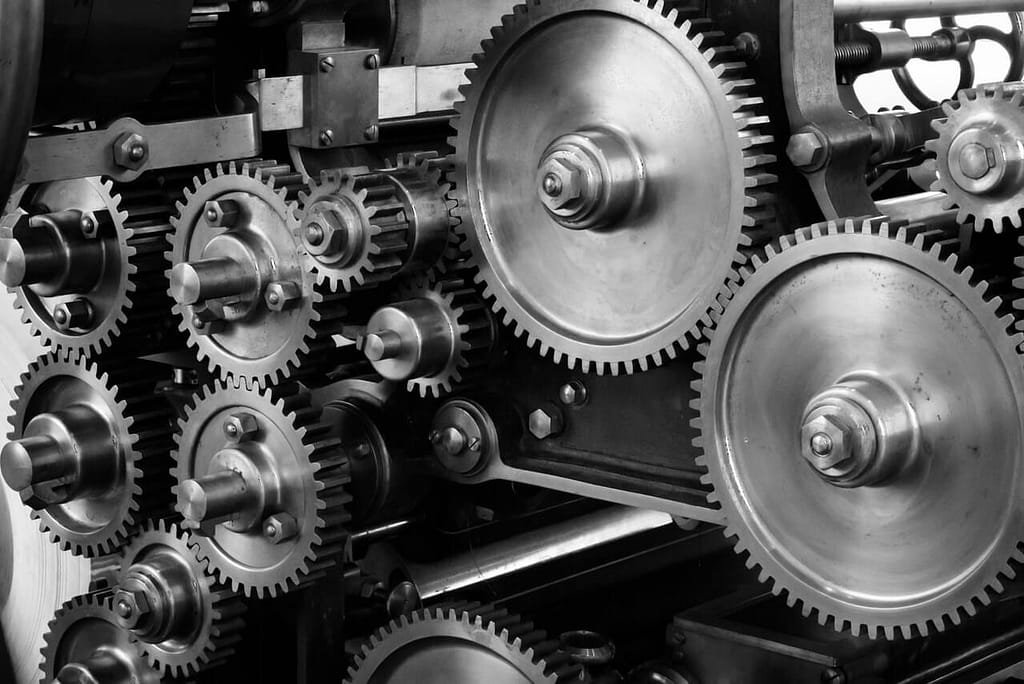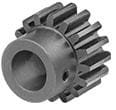Different Types of Gears and Their Uses
Gears are fundamental machine elements with various types and categories that are used for power transmission with a pair of meshing. Depending on the design requirements, different types of gear are used for different purposes. Actually, gears are everywhere, such as in automobiles, heavy machinery, shipbuilding industries, gearboxes, watches, etc. Depending on the application and requirements, various types of gear are used. The size of the gear wheel, as well as the material and geometric shape of the gear, vary depending on the application.
For those applications, there are a lot of gear types and verities as follows,
- Spur Gears
- Single Helical Gears
- Double Helical Gears
- Rack and Pinion
- Planetary Gears
- Worm and Wheel
- Bevel Gears
- Non–Circular Gears
- Ratchets
Basically, these gears are classified into several categories according to the axis of the shaft, gear velocities, types of gears & teeth on the gear surface. Above all are basic or traditional gear types and in today’s world, there are different types of gear used for industrial product design.

Categories of Different types of gears
Axes of the shaft
- Parallel – Spur Gears, Single Helical Gears, Double Helical Gears
- Intersecting – Bevel gears
- Non – Intersecting – Skew Bevel Gears/ Spiral Gears
Peripheral Velocity
- Low – Less than 3m/s-1
- Medium – In between 3-15m/s-1
- High – Above the 15m/s-1
Gearing Type
- External Gears
- Internal Gears
- Rack and Pinion
Position of Teeth on the Surface
- Straight
- Inclined
- Curved
Different types of gears
Spur Gears:
Spur gears are mainly based on two pressure angles 20° and 14.5°, However, 20° pressure angle gear wheels have thicker and stronger gear teeth than 14.5° pressure angle gears. These gears are better for high-speed, high-load transmission, and heavy-duty applications. Therefore spur gear wheels are more common. The Spur gears transmit power through a parallel shaft with more noise than helical gears due to a single contact line between teeth. Spur gears only produce a radial force on the shaft and no axial force generates.

The most common gear type is Super Gear and which is easy to use, easy to design, and easy to manufacture as well.
Different types of Helical Gears
Helical gears there are two types, Single helical and double helical gears and gear teeth have on helix curve. However helical gears give the advantage of high load and high speed than spur gears. If you need to buy or manufacture helix gears make sure to get right-hand and left-hand gear wheels for the gear pair. A different number of gear teeth will change the speed and torque of the transmission of the gear assembly.
Single Helical Gears
The major disadvantage of the single helical gears is there is an axial thrust in the single helical gears. Usually, the helix angle of the single helical gear is 15-20 degrees and the price of the single helical gears is lower than the double-helical gears.


Double Helical Gears
“Herringbone gears” is the one of calling names for the double-helical gears. Axial thrust is canceled off in the double-helical gears due to two opposite axial thrusts. Because of that, this one has a 20-45 degree helix angle. Double helical gears can use for your design to get high power transmission and high efficiency.
Rack and Pinion
The rack and pinion can use for achieving the rectilinear and rotary motion to full fill your design requirements. There are two types of rack and pinion. Those are straight racks that can be used for spur gear wheels and additionally helical racks can be used for helical gear wheels.

Worm and Wheel gear types
The Worm and wheel gear systems can use for your design to get very high-velocity ratios, for instance, 300:1 velocity reduction.

Three types of worm and wheel systems are,
- Straight face worm gears – can use for light services
- Hobbed straight-face worm gears – can use for light services
- Concave face worm gears – can use for heavy services and are common for industrial use.
Bevel Gear types
The bevel gears can use your design to get the constant velocity ratio and transmit power between two axes that are intersecting at a certain angle. according to the intersecting angle, there are different types of bevel gears. Bevel gears are most commonly used to change the transmission direction therefore you can see bevel gears in vehicle differentials.

- Straight bevel gear or Miter gears
- Angular straight bevel gears
- Spiral bevel gears
- Angular spiral bevel gears
Ratchets
Gear ratchets can use for preventing unwanted motion of the gear system and they can use as a locking mechanism for unique designs. Ratchets can apply high-speed, high-load, and heavy-duty applications. for instance, tie-downs, jacks, winches, and ratchets gears are good examples.

These are the basic types of gear types and other than the above-discussed gear types planetary gear systems and Non-Circular gears can be identified.
Different types of Gears and their uses
There are a lot of mechanical power transmission methods. But, Designers and Product Designers are using different types of gear for their products for power transmission and other design requirements. rather than using a belt drive, chain drive, or other methods designers select the gear drives due to the special features of gears. Even so, designing and price of the gears are high it giving rigid transmission compared to other transmission methods.
As we know in NANO level to Micro and Macro level designs we use gears. In addition, we use gears for NEMS-Nano Electromechanical Systems and MEMS-Micro Electromechanical Systems. The materials of the gears depending on the mechanical requirement of the design. There are a lot of online markets in which we can buy gear according to our requirements like McMaster and there are some categories accordingly to our engineering perspective. However, we can buy custom gears for our designs where the manufacturers manufacture custom gears.
The most common applications of the gears are;
- Hand and Wall Watches
- Gear Boxes of an engine
- Vehicle differential
- Conveyor systems
Furthermore, gears are used in motors and actuators for speed reduction. Nevertheless, Gear pumps, electrical vehicle power transmission lines, railways, elevator systems, and hand drills are some good examples of gear applications.

Different Types of Creative Gears
Rather than the conventional gear designs designers tend to use creative gear designs for their creative designs. However, designing and manufacturing creative gear is very difficult. We all are using complete gearwheels for designs but we can use half gears as well. But for half gears, we have to go for a manufacturing process like EDM wire cut. These kinds of gear manufacturing processes make highly expensive gear but finally, give more mechanical movements. However, all of these creative gears are compatible with gear design theories and design guidelines. Creative gears are a trending area of the gear design industry and generating creative gear design is much more difficult to use rather conventional gears.
The main purpose of the gear system is power transmission but in addition to that speed reduction and change in the transmission, and direction is also some additional advantages.
Different Gear Types with Different Materials
Depending on the application and industry, different gear materials are used in different gear types. Brass, Carbon Steel, Stainless Steel, Aluminum alloys, Mild Steel, and Plastic materials are commonly used, depending on the application. Brass is a good material for gear manufacturing because brass gears and racks are simple to machine. When exposed to water, they will not rust.
Carbon steel elements have hard, strong, and wear-resistant teeth, but when exposed to moisture and corrosive chemicals, they rust. They are best suited for high-torque machines such as lifting equipment and heavy-duty applications such as rock crushing. Hardened teeth are used in some carbon steel gears to improve wear resistance. Gears with unhardened teeth can be hardened to match your application.
There are different types of stainless steel like 304SS, 316SS, 15-5PH, and many other stainless steel grades. Because stainless steel gears and racks resist rust in damp and wet environments, they are commonly used in food processing plants and other areas that require frequent cleaning. Spacers work with our metric gear racks to eliminate the guesswork and measuring required to install two racks end-to-end, allowing your gear to roll smoothly from one rack to the next.
Plastic Gears
Plastic Gears are also used in some applications to take advantage of the properties of plastic materials. Acetal, Polycarbonate, Nylon, and UHMW are examples of common materials used in gear manufacturing. Acetal gears are lightweight, nonconductive, and quiet. Press them onto the shaft of your machine or gear system. Acetal gear racks absorb less water than nylon racks and swell less as a result. Nylon gear racks are lightweight, corrosion-resistant, and operate quietly. They do not require lubrication. UHMW They are corrosion and abrasion resistant and are commonly used in harsh environments and wet conditions.
Really appreciate your taking the time to read the article about gear types. Furthermore, we will discuss how to apply these gear types for a design. So keep in touch with MechHeart and feel free to add some comments here and share your knowledge with us.



0 Comments